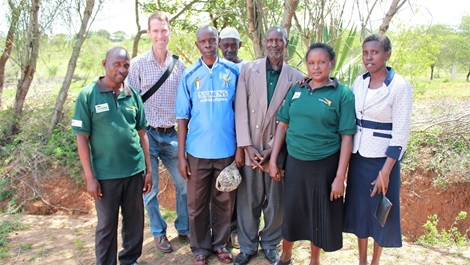
Reversing land degradation, Yatta kenya
December 8, 2017
Rob Kelly – World Vision Australia
The Drylands Development Programme, or DryDev (drydev.org), a Dutch government and World Vision Australia funded farmer-led initiative, is developing approaches that enable dryland farmers to restore degraded landscape in eastern Kenya.
In Yatta, the DryDev farmer’s group were eager to recover a patch of land that was previously used as a cattle dip. Since the dip’s closure, the 1 ha site had failed to recover, even grasses struggling to return and cover the ground.
The group wished to showcase approaches that would reverse land degradation, such as FMNR and a suite of soil conservation techniques.
The community evidently liked a challenge: the cattle trampling had left a compaction layer that blocked even the most energetic weed. Goats free-grazing the area had further stripped the trees and pulled out any grass, exposing the topsoil to rain and wind erosion.
Around 60 farmers got involved starting last year. A living fence – made up of trunks from young Acacia trees serving as posts – was placed around the area to keep out the goats and roaming cattle. Contour banks and water-catching trenches were put in with the help of a hired excavator and manual labour; these structures would slow the flow of rainwater run-off.

Teams were trained in FMNR, and some began to practice on the few short Acacia stumps remaining. Grass and tree seeds, rolled in charcoal to remain hidden from termites, were scattered. A ripper was used to break up the compaction.
With just a short period of rainfall since the onset of the November wet season, the living fence posts have sprouted. Stumps have rejuvenated, and tree seeds are emerging. Grassy patches are expanding. The trenches have filled again and again with water, preventing rain from causing sheet erosion and allowing rainwater to infiltrate into the groundwater table.
The committee that oversees the site, led by FMNR champions Carol, Joseph and Philomena, told us “seeing is believing, and doing is learning”. They set up the FMNR demonstration plot because “their community needed to see that it was possible to restore degraded areas, to appreciate the need to protect the land, and to learn how to do it”.

After a year, it was clear how fast things change: the area still carries the scars of degradation, but a recovery is underway. What might have been a hopeless situation is reversing. “We will carry on until the situation improves even further,” said Dominic, one of the committee members.
The committee expressed it this way: “land restoration is bringing hope and a promise of better things ahead”.
